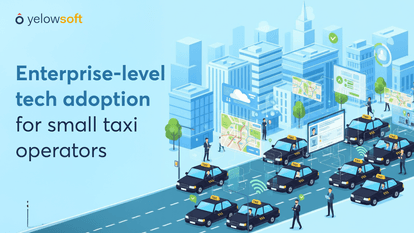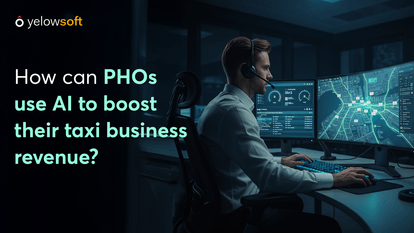If you run a taxi business, you already know the struggle. Some drivers sit idle in quiet neighborhoods, while customers in high-demand areas wait far too long for a ride.
Fuel gets wasted, earnings drop, and passengers lose patience. The truth is, relying on reactive dispatching doesn’t work in 2025.
That’s where analytics come in. With the right tools, you can move from chasing rides to predicting them. Using predictive analysis in taxi software, operators can identify patterns before they happen.
Whether it’s Friday night downtown, early morning airport runs, or seasonal spikes in tourist spots, you can prepare your fleet in advance.
In this blog, we’ll explore how demand prediction in taxi software works, the role of analytics software in taxi software, and how heatmaps in taxi software give you the visual clarity to act fast. The future of dispatch is predictive — and it starts here.
The Problem With Reactive Dispatch
Relying on reactive dispatch leaves taxis idle in low-demand areas while passengers wait elsewhere, causing wasted fuel, lost revenue, and frustrated customers.
Why Traditional Dispatch Models Fall Short
Most taxi operators still work in a reactive mode. Dispatchers wait for customer requests to arrive, then scramble to assign the nearest driver.
While this method worked years ago, it creates major inefficiencies today.
- Drivers waste fuel circling empty streets.
- Customers face long wait times during demand spikes.
- Dispatchers lose control when multiple requests arrive at once.
This reactive approach keeps businesses in a cycle of missed opportunities and dissatisfied customers.
The Hidden Cost of Idle Drivers
Every idle minute adds up. When a driver sits in a low-demand area, not only are you losing revenue, but operating costs continue to rise. Idle time leads to:
- Higher fuel expenses
- Fewer completed trips per shift
- Lower driver morale and retention issues
Without smarter tools, operators are stuck responding to problems instead of preventing them. That’s why the industry is shifting toward predictive analysis in taxi software.
What Is Predictive Analysis in Taxi Software?
Predictive analysis in taxi software is the game-changer that turns raw trip data into foresight.
Instead of waiting for rides to be booked, operators can anticipate where requests will come from and position drivers accordingly.
By analyzing past trips, peak hours, weather conditions, and local events, the system can forecast demand patterns with impressive accuracy.
How Demand Prediction Changes Taxi Operations
Predicting demand before it happens is the new standard in taxi management.
With demand prediction in taxi software, operators can allocate drivers in advance to hotspots like airports on weekends or downtown during rush hours.
This proactive approach minimizes idle time and ensures passengers never wait too long.
Smarter Resource Allocation
Instead of scrambling after requests arrive, dispatchers can position vehicles near areas where demand is likely to rise.
For example, knowing that Saturday evenings bring high traffic near entertainment districts allows you to schedule drivers accordingly.
Real-World Scenarios
Airports see predictable surges in the early mornings and late evenings. City centers often peak around commuting hours.
By analyzing these patterns, taxi operators can place drivers closer to these zones before demand spikes, cutting both wait times and lost revenue.
Customer Experience Boost
Passengers benefit most when cars are already nearby. Faster pickups improve satisfaction and increase the chances of repeat business.
With demand forecasting, operators not only improve efficiency but also strengthen customer trust.
The Role of Analytics in Taxi Dispatch
Numbers are the foundation of every taxi operation. But raw data alone isn’t enough.
Analytics software in taxi software transforms trip details, ride frequency, and driver metrics into actionable insights that drive smarter decisions.
Tracking Key Performance Indicators
KPIs such as completed trips per driver, average wait time, and cancellation rates provide a clear picture of operational health.
Dispatchers can identify weak spots and act quickly to correct them.
Understanding Driver Performance
Not all drivers perform at the same level. Analytics shows who consistently accepts rides, maintains punctuality, and delivers quality service.
This helps in creating better incentive systems and training programs.
Monitoring Ride Frequency and Trends
Seasonal changes, holidays, and local events all impact ride frequency.
By spotting these patterns, operators can anticipate demand swings and adjust resources ahead of time, ensuring no business is lost.
Data-Driven Decision-Making
The real power of analytics is turning numbers into strategy. Operators can reduce costs, optimize fuel use, and improve fleet utilization by basing decisions on data rather than instinct.
Visualizing Demand With Heatmaps
When data becomes visual, it tells a story at a glance.
Heatmaps in taxi software highlight areas where ride requests are most likely to surge, such as airports, stadiums, or city centers during peak hours.
By seeing these hotspots in real time, operators can direct drivers strategically and avoid wasted trips.
Turning Data Into Visual Clarity
Numbers on a spreadsheet can be overwhelming. A heatmap instantly shows red zones for high demand, green zones for low activity, and everything in between.
This makes it easier for dispatchers to make fast, informed decisions.
Anticipating Rush Hours and Events
Heatmaps help operators prepare for predictable demand spikes — downtown offices at morning rush, entertainment districts on weekend nights, or hotels during tourist season.
Drivers placed near these hotspots complete more trips per shift.
Boosting Fleet Efficiency
Efficient allocation doesn’t just increase revenue; it also lowers costs.
Drivers spend less time roaming aimlessly, fuel consumption drops, and the business benefits from higher productivity with the same fleet size.
Enhancing Driver and Customer Experience
When drivers are guided to areas where rides are likely, their earning potential increases.
At the same time, passengers enjoy faster pickups and reduced waiting times. Heatmaps create a win-win scenario for both sides of the trip.
Benefits of Predictive Analytics for Operators
Predictive analytics isn’t just a buzzword — it’s a practical advantage that taxi operators can use to cut costs, improve efficiency, and build stronger customer relationships.
By turning raw data into clear foresight, businesses gain the power to optimize every trip.
Cost Savings Through Smarter Planning
When cars are placed where demand is about to rise, fewer drivers roam empty streets.
This reduces wasted mileage and fuel expenses.
According to McKinsey, companies that embed advanced analytics in operations report efficiency gains of 15–20%, which directly translates into higher profit margins for fleets.
Higher Driver Earnings
Drivers thrive when they spend less time idle and more time completing trips.
With demand prediction in taxi software, operators can ensure their workforce is positioned for success.
More trips per shift means higher income for drivers, which improves retention and reduces turnover.
Customer Satisfaction at Scale
Passengers care about one thing most: how quickly a car arrives.
By using predictive analysis in taxi software, operators shorten pickup times.
Faster, more reliable service boosts customer satisfaction scores and increases repeat business — a key driver of long-term revenue growth.
Competitive Advantage in the Market
Not every taxi business has embraced analytics software in taxi software. This means operators who adopt predictive tools early gain a competitive edge.
As one Uber case study revealed, predictive placement strategies reduced average wait times by nearly 30%, giving them a clear market advantage.
Smaller operators can now leverage similar tools to stay ahead of larger competitors.
How to Get Started With Analytics in Your Taxi Business
Adopting predictive analytics may sound complex, but getting started is easier than most operators think.
With the right system, you can begin transforming your taxi business in a matter of weeks.
Choose the Right Platform
Look for taxi dispatch software that includes predictive analysis in taxi software, demand forecasting, and heatmaps in taxi software.
This ensures your team has the tools needed to stay proactive instead of reactive.
Train Your Team
Technology only works if people know how to use it. Dispatchers should understand how to read dashboards, while drivers should know how to position themselves in high-demand zones suggested by the system.
Start Small and Scale
You don’t need to change everything at once. Begin with one shift or a single service area. Once you see improvements in trip volume and reduced idle time, expand to your entire fleet.
Measure and Improve
Use analytics software in taxi software to track KPIs like ride frequency, cancellations, and wait times.
Continuous monitoring helps you refine strategies and ensures your predictive tools deliver maximum value.
Conclusion
The days of reactive dispatch are over. In 2025, success depends on being proactive, and predictive analytics is the path forward.
By using demand prediction in taxi software, operators can place drivers where rides are likely to occur, cut idle time, and reduce fuel costs.
With analytics software in taxi software and heatmaps in taxi software, decision-making becomes faster, smarter, and more accurate.
The result is higher driver earnings, happier passengers, and a stronger competitive edge in a crowded market.
Whether you run a small fleet or manage operations across multiple cities, predictive analytics gives you the clarity to grow with confidence.
Now is the time to act. Future-proof your business and give your team the tools they need to succeed.
FAQs
Predictive analysis in taxi software uses past trip data, traffic, and local events to forecast where ride demand will rise. This helps operators plan ahead, place drivers in the right zones, and reduce idle time.
Demand prediction in taxi software allows fleets to prepare for peak hours before requests come in. By forecasting demand around hotspots like airports or city centers, operators improve driver efficiency and reduce passenger waiting times.
Analytics software in taxi software tracks KPIs such as ride frequency, driver performance, and customer patterns. This data-driven approach empowers operators to make smarter decisions and boost fleet profitability.
Yes. heatmaps in taxi software visually highlight high-demand zones, making it easier for dispatchers to allocate resources effectively. Drivers benefit from more trips per shift, while passengers enjoy faster pickups.
Absolutely. predictive analysis in taxi software isn’t limited to large fleets. Even small operators can use forecasting and analytics to optimize routes, cut wasted fuel, and deliver better service with fewer cars on the road.
Yes. Yelowsoft includes built-in predictive tools, analytics software in taxi software, and heatmaps in taxi software. These features help businesses of all sizes scale efficiently and deliver consistent customer satisfaction.




